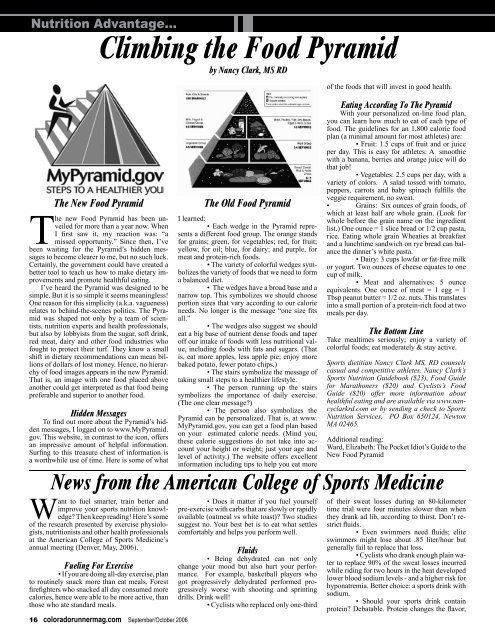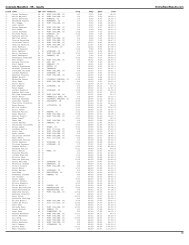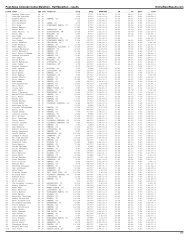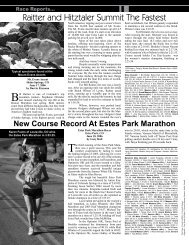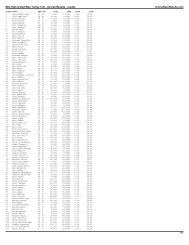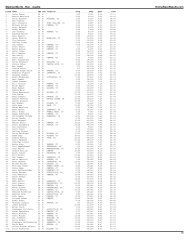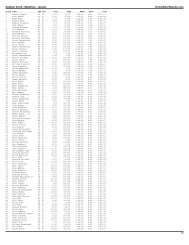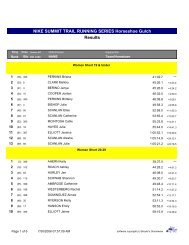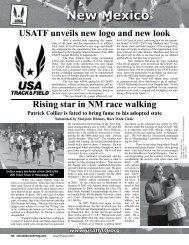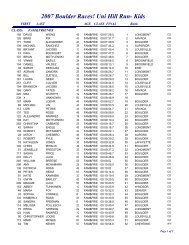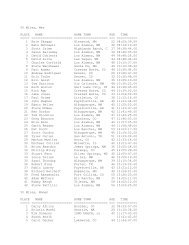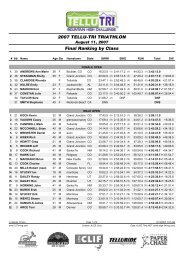Climbing the Food Pyramid - Colorado Runner
Climbing the Food Pyramid - Colorado Runner
Climbing the Food Pyramid - Colorado Runner
You also want an ePaper? Increase the reach of your titles
YUMPU automatically turns print PDFs into web optimized ePapers that Google loves.
Nutrition Advantage...<br />
<strong>Climbing</strong> <strong>the</strong> <strong>Food</strong> <strong>Pyramid</strong><br />
by Nancy Clark, MS RD<br />
The New <strong>Food</strong> <strong>Pyramid</strong><br />
The new <strong>Food</strong> <strong>Pyramid</strong> has been unveiled<br />
for more than a year now. When<br />
I first saw it, my reaction was: “a<br />
missed opportunity.” Since <strong>the</strong>n, I’ve<br />
been waiting for <strong>the</strong> <strong>Pyramid</strong>’s hidden messages<br />
to become clearer to me, but no such luck.<br />
Certainly, <strong>the</strong> government could have created a<br />
better tool to teach us how to make dietary improvements<br />
and promote healthful eating.<br />
I’ve heard <strong>the</strong> <strong>Pyramid</strong> was designed to be<br />
simple. But it is so simple it seems meaningless!<br />
One reason for this simplicity (a.k.a. vagueness)<br />
relates to behind-<strong>the</strong>-scenes politics. The <strong>Pyramid</strong><br />
was shaped not only by a team of scientists,<br />
nutrition experts and health professionals,<br />
but also by lobbyists from <strong>the</strong> sugar, soft drink,<br />
red meat, dairy and o<strong>the</strong>r food industries who<br />
fought to protect <strong>the</strong>ir turf. They know a small<br />
shift in dietary recommendations can mean billions<br />
of dollars of lost money. Hence, no hierarchy<br />
of food images appears in <strong>the</strong> new <strong>Pyramid</strong>.<br />
That is, an image with one food placed above<br />
ano<strong>the</strong>r could get interpreted as that food being<br />
preferable and superior to ano<strong>the</strong>r food.<br />
Hidden Messages<br />
To find out more about <strong>the</strong> <strong>Pyramid</strong>’s hidden<br />
messages, I logged on to www.My<strong>Pyramid</strong>.<br />
gov. This website, in contrast to <strong>the</strong> icon, offers<br />
an impressive amount of helpful information.<br />
Surfing to this treasure chest of information is<br />
a worthwhile use of time. Here is some of what<br />
16 coloradorunnermag.com September/October 2006<br />
The Old <strong>Food</strong> <strong>Pyramid</strong><br />
I learned:<br />
• Each wedge in <strong>the</strong> <strong>Pyramid</strong> represents<br />
a different food group. The orange stands<br />
for grains; green, for vegetables; red, for fruit;<br />
yellow, for oil; blue, for dairy; and purple, for<br />
meat and protein-rich foods.<br />
• The variety of colorful wedges symbolizes<br />
<strong>the</strong> variety of foods that we need to form<br />
a balanced diet.<br />
• The wedges have a broad base and a<br />
narrow top. This symbolizes we should choose<br />
portion sizes that vary according to our calorie<br />
needs. No longer is <strong>the</strong> message “one size fits<br />
all.”<br />
• The wedges also suggest we should<br />
eat a big base of nutrient dense foods and taper<br />
off our intake of foods with less nutritional value,<br />
including foods with fats and sugars. (That<br />
is, eat more apples, less apple pie; enjoy more<br />
baked potato, fewer potato chips.)<br />
• The stairs symbolize <strong>the</strong> message of<br />
taking small steps to a healthier lifestyle.<br />
• The person running up <strong>the</strong> stairs<br />
symbolizes <strong>the</strong> importance of daily exercise.<br />
(The one clear message)<br />
• The person also symbolizes <strong>the</strong><br />
<strong>Pyramid</strong> can be personalized. That is, at www.<br />
My<strong>Pyramid</strong>.gov, you can get a food plan based<br />
on your estimated calorie needs. (Mind you,<br />
<strong>the</strong>se calorie suggestions do not take into account<br />
your height or weight; just your age and<br />
level of activity.) The website offers excellent<br />
information including tips to help you eat more<br />
of <strong>the</strong> foods that will invest in good health.<br />
Eating According To The <strong>Pyramid</strong><br />
With your personalized on-line food plan,<br />
you can learn how much to eat of each type of<br />
food. The guidelines for an 1,800 calorie food<br />
plan (a minimal amount for most athletes) are:<br />
• Fruit: 1.5 cups of fruit and or juice<br />
per day. This is easy for athletes: A smoothie<br />
with a banana, berries and orange juice will do<br />
that job!<br />
• Vegetables: 2.5 cups per day, with a<br />
variety of colors. A salad tossed with tomato,<br />
peppers, carrots and baby spinach fulfills <strong>the</strong><br />
veggie requirement, no sweat.<br />
• Grains: Six ounces of grain foods, of<br />
which at least half are whole grain. (Look for<br />
whole before <strong>the</strong> grain name on <strong>the</strong> ingredient<br />
list.) One ounce = 1 slice bread or 1/2 cup pasta,<br />
rice. Eating whole grain Wheaties at breakfast<br />
and a lunchtime sandwich on rye bread can balance<br />
<strong>the</strong> dinner’s white pasta.<br />
• Dairy: 3 cups lowfat or fat-free milk<br />
or yogurt. Two ounces of cheese equates to one<br />
cup of milk.<br />
• Meat and alternatives: 5 ounce<br />
equivalents. One ounce of meat = 1 egg = 1<br />
Tbsp peanut butter = 1/2 oz. nuts. This translates<br />
into a small portion of a protein-rich food at two<br />
meals per day.<br />
The Bottom Line<br />
Take mealtimes seriously; enjoy a variety of<br />
colorful foods; eat moderately & stay active.<br />
Sports dietitian Nancy Clark MS, RD counsels<br />
casual and competitive athletes. Nancy Clark’s<br />
Sports Nutrition Guidebook ($23), <strong>Food</strong> Guide<br />
for Marathoners ($20) and Cyclists’s <strong>Food</strong><br />
Guide ($20) offer more information about<br />
healthful eating and are available via www.nancyclarkrd.com<br />
or by sending a check to Sports<br />
Nutrition Services, PO Box 650124, Newton<br />
MA 02465.<br />
Additional reading:<br />
Ward, Elizabeth: The Pocket Idiot’s Guide to <strong>the</strong><br />
New <strong>Food</strong> <strong>Pyramid</strong><br />
News from <strong>the</strong> American College of Sports Medicine<br />
Want to fuel smarter, train better and<br />
improve your sports nutrition knowledge<br />
Then keep reading! Here’s some<br />
of <strong>the</strong> research presented by exercise physiologists,<br />
nutritionists and o<strong>the</strong>r health professionals<br />
at <strong>the</strong> American College of Sports Medicine’s<br />
annual meeting (Denver, May, 2006).<br />
Fueling For Exercise<br />
• If you are doing all-day exercise, plan<br />
to routinely snack more than eat meals. Forest<br />
firefighters who snacked all day consumed more<br />
calories, hence were able to be more active, than<br />
those who ate standard meals.<br />
• Does it matter if you fuel yourself<br />
pre-exercise with carbs that are slowly or rapidly<br />
available (oatmeal vs white toast) Two studies<br />
suggest no. Your best bet is to eat what settles<br />
comfortably and helps you perform well.<br />
Fluids<br />
• Being dehydrated can not only<br />
change your mood but also hurt your performance.<br />
For example, basketball players who<br />
got progressively dehydrated performed progressively<br />
worse with shooting and sprinting<br />
drills. Drink well!<br />
• Cyclists who replaced only one-third<br />
of <strong>the</strong>ir sweat losses during an 80-kilometer<br />
time trial were four minutes slower than when<br />
<strong>the</strong>y drank ad lib, according to thirst. Don’t restrict<br />
fluids.<br />
• Even swimmers need fluids; elite<br />
swimmers might lose about .85 liter/hour but<br />
generally fail to replace that loss.<br />
• Cyclists who drank enough plain water<br />
to replace 90% of <strong>the</strong> sweat losses incurred<br />
while riding for two hours in <strong>the</strong> heat developed<br />
lower blood sodium levels - and a higher risk for<br />
hyponatremia. Better choice: a sports drink with<br />
sodium.<br />
• Should your sports drink contain<br />
protein Debatable. Protein changes <strong>the</strong> flavor,
so athletes tend to drink less; sub-optimal hydration<br />
could hinder performance.<br />
Protein For Recovery<br />
• The jury is out whe<strong>the</strong>r protein (or<br />
amino acids, <strong>the</strong> building blocks of protein)<br />
added to a sports drink enhances performance.<br />
But consuming a carb plus a protein beverage<br />
before or right after a muscle damaging workout<br />
does reduce post-exercise muscle soreness.<br />
<strong>Runner</strong>s who took branch-chain amino acids<br />
(that readily convert into glucose for fuel) before<br />
and after each of three daily bouts of hard<br />
exercise reported less muscle soreness and fatigue.<br />
The researchers attributed this to having<br />
less muscle damage and inflammation.<br />
• Does <strong>the</strong> amino acid taurine enhance<br />
energy Doubtful. When cyclists consumed<br />
2,000 mg of taurine (double <strong>the</strong> amount<br />
in a can of Red Bull) one hour before a 90 minute<br />
bike ride followed by a time trial, <strong>the</strong> taurine<br />
offered no benefits compared to <strong>the</strong> same<br />
beverage without taurine.<br />
Protein For Building Muscles<br />
Some body builders wonder if a very<br />
high protein intake will affect <strong>the</strong>ir long-term<br />
health. An 8-week study with strength athletes<br />
who consumed 3 grams protein/kg (~1.5 grams<br />
protein/lb) showed no signs of damage to liver<br />
and kidney function. This equates to 210 grams<br />
of protein for a 154 pound athlete. That’s 35<br />
eggs!<br />
Aging And Exercise<br />
Without a doubt, exercise protects<br />
and improves our mental function (to say nothing<br />
of our overall health). The question arises:<br />
How long will it be before doctors routinely<br />
prescribe exercise<br />
• In a study of seniors who were at<br />
least 65 years old who completed a 20-week<br />
exercise program, some of <strong>the</strong> subjects actually<br />
moved from <strong>the</strong> category “demented” to “normal.”<br />
Now that’s incentive to keep moving!<br />
• While we assume that exercise<br />
is good for our health, we may overlook <strong>the</strong><br />
impact of injuries. A survey of 375 former Division-I<br />
athletes (of whom 41% had played<br />
football) indicates 36% of <strong>the</strong> former athletes<br />
vs 6% of non-athlete alums had limitations in<br />
exercise due to old injuries. Exercise wisely!!<br />
Childhood Obesity<br />
The rapid increase in childhood obesity<br />
is worrisome because so many obese kids<br />
are developing diabetes and heart disease - conditions<br />
associated with old age. One solution is<br />
to add exercise back into daily life. A safe and<br />
socially accepted way to do this is to organize<br />
a Walking School Bus in your neighborhood; a<br />
parent or hired college student chaperones <strong>the</strong><br />
group of children.<br />
Exercise can also be added into <strong>the</strong><br />
school curriculum, but many schools are reluctant<br />
to do so. The assumption is less class time<br />
will contribute to lower test scores. Not <strong>the</strong><br />
case. When students ate a free school breakfast,<br />
participated in 15 minutes of teacher-led activity<br />
each morning, and had mid-day recess before<br />
lunch, <strong>the</strong>ir test scores improved plus <strong>the</strong><br />
teachers had 58% fewer discipline referrals.<br />
Weight<br />
• Two contributors to undesired fat<br />
gain are sugar-sweetened soft drinks and a sedentary<br />
lifestyle. Contributors to successful fat<br />
loss include weekly weigh-ins, at least 30 minutes<br />
per day of (ideally, supervised) exercise,<br />
and daily food records. Standing more often<br />
also helps with weight management. That is,<br />
obese people - who tend to sit 2.5 hours more<br />
per day than <strong>the</strong>ir lean counterparts - can potentially<br />
save 350 calories per day. Get rid of<br />
<strong>the</strong> chairs!<br />
• Yes, achieving a healthy weight is<br />
important. But <strong>the</strong> desire to get too thin can<br />
lead to health problems. Among 80 varsity high<br />
school athletes at an all-girls school, 74% had<br />
at least one component of <strong>the</strong> Female Athlete<br />
Triad - a syndrome with loss of menstrual periods,<br />
disordered eating, and stress fractures.<br />
Fifty-five percent ate inadequate calories, 30%<br />
had a history of amenorrhea, and 19% a history<br />
of stress fractures. Is “thin at any price” worth<br />
<strong>the</strong> cost..<br />
Body Image<br />
While you are exercycling at <strong>the</strong><br />
gym, be forewarned: If you look at magazine<br />
ads with ultra-fit bodies, you may experience<br />
increased anxiety and depression and a change<br />
of mood. Choose your magazines carefully!<br />
September/October 2006 coloradorunnermag.com 17<br />
<br />
<br />
<br />
<br />
<br />
<br />
<br />
<br />
<br />
<br />
<br />
CALL FOR FREE<br />
CONSULTATION.<br />
<br />
<br />
<br />
<br />
303-475-9863<br />
simicapm@msn.com


